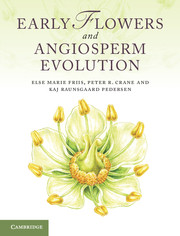Book contents
- Frontmatter
- Contents
- Preface
- 1 Introduction to angiosperms
- 2 The nature of the angiosperm fossil record
- 3 The environmental context of early angiosperm evolution
- 4 Stratigraphic framework and key areas for Cretaceous angiosperms
- 5 Angiosperms in context: extant and fossil seed plants
- 6 Origin and age of angiosperms
- 7 Phylogenetic framework and the assignment of fossils to extant groups
- 8 Fossils near the base of the angiosperm tree
- 9 Early fossil angiosperms of uncertain relationships
- 10 Early fossils of eumagnoliids
- 11 Fossils of monocots
- 12 Fossils of eudicots: early-diverging groups
- 13 Fossils of core eudicots: basal lineages
- 14 Fossils of core eudicots: rosids
- 15 Early fossils of eudicots: asterids
- 16 Patterns of structural diversification in angiosperm reproductive organs
- 17 History and evolution of pollination in angiosperms
- 18 History and evolution of dispersal in angiosperms
- 19 Vegetational context of early angiosperm diversification
- 20 The accumulation of angiosperm diversity
- References
- Index
15 - Early fossils of eudicots: asterids
Published online by Cambridge University Press: 07 September 2011
- Frontmatter
- Contents
- Preface
- 1 Introduction to angiosperms
- 2 The nature of the angiosperm fossil record
- 3 The environmental context of early angiosperm evolution
- 4 Stratigraphic framework and key areas for Cretaceous angiosperms
- 5 Angiosperms in context: extant and fossil seed plants
- 6 Origin and age of angiosperms
- 7 Phylogenetic framework and the assignment of fossils to extant groups
- 8 Fossils near the base of the angiosperm tree
- 9 Early fossil angiosperms of uncertain relationships
- 10 Early fossils of eumagnoliids
- 11 Fossils of monocots
- 12 Fossils of eudicots: early-diverging groups
- 13 Fossils of core eudicots: basal lineages
- 14 Fossils of core eudicots: rosids
- 15 Early fossils of eudicots: asterids
- 16 Patterns of structural diversification in angiosperm reproductive organs
- 17 History and evolution of pollination in angiosperms
- 18 History and evolution of dispersal in angiosperms
- 19 Vegetational context of early angiosperm diversification
- 20 The accumulation of angiosperm diversity
- References
- Index
Summary
The asterids are an extraordinarily diverse group of extant angiosperms that includes more than 80 000 species. The clade also includes two of the most species-rich angiosperm families, the Asteraceae and the Rubiaceae (Bremer et al., 2004) as well as some of the largest angiosperm genera (e.g. Solanum). Asterids have an extensive fossil record in the Cenozoic, but their representation in the Cretaceous is more limited and largely confined to Cornales and Ericales.
Classification of asterids
As currently defined by molecular data, asterids include four major clades: Cornales, Ericales, lamiids (Euasterid I), and campanulids (Euasterid II) (Figure 15.1). Cornales are resolved as the earliest-diverging of these four main lineages. They are followed by the Ericales, which are sister to the core asterids, which comprises lamiids and campanulids (APGIII, 2009). Molecular support for the recognition of the asterids as a whole is good, and there is also generally strong support for relationships within the group, although molecular support for the campanulids is weak (Judd and Olmstead, 2004; Soltis et al., 2005).
- Type
- Chapter
- Information
- Early Flowers and Angiosperm Evolution , pp. 361 - 386Publisher: Cambridge University PressPrint publication year: 2011



